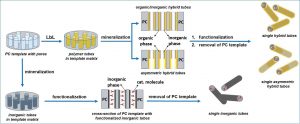The “Seed Funding” initiative of CRC 1333 aims to establish new directions of research within the framework of the CRC 1333. Specifically young researchers can apply. Using the grant, they can follow new paths and find out if a new research questions should be investigated further, potentially in the next CRC funding period. The seed funding includes one year of personnel funding for a doctoral researcher plus required materials expenses.
The following CRC 1333 researchers receive seed funding grants:
2019
Seed 1, Dr. Petia Atanasova
Seed 2, apl. Prof. Dr. Maria Fyta
Seed 3, Dr. Johanna Bruckner, Dr. Stefan Naumann
2020
Seed 4, Dr. Mark Ringenberg
Seed 5, apl. Prof. Dr.-Ing. Niels Hansen
Please find more information on the projects below.
Seed Funding Project 1
Synthesis of organic-inorganic microtubes with mesoporous channels and tunable geometry for heterogeneous catalysis
Principal Investigator: Dr. Petia Atanasova

Organic-inorganic or pure inorganic microtubes with mesoporous channels and tunable geometry shall be prepared as catalyst supports for molecular heterogeneous catalysis. To do this, a template with tube-like pores will be used. The assembled organic part of the hybrid microtubes should serve further as a template for the deposition of the inorganic material, presented by various oxides and produced applying mild reaction conditions. Catalyst molecules shall be selectively attached on the inner tube walls using “click” chemistry. The influence of the confinement on the mineralization mechanism of the deposited oxides as well as on the investigated heterogeneous catalytic reactions will be studied.
Seed Funding Project 2
Influence of ionic-liquids and confinement on organometallic catalysts
Principal Investigator: apl. Prof. Dr. Maria Fyta
This project targets the possibility for a linker-free immobilization of catalysts in a pore through the supported ionic liquid phase technology. It is dedicated in providing insight on the role of ionic liquids (ILs) on the confinement of catalysts in nanopores. Through computer simulations, information will be gained on the influence of steric and IL-specific effects, the structuring of a varying solvent environment, the pore functionality/polarity, and their synergistic interactions with the catalytic center. The aim is to promote a deeper understanding on the micro-details for a rational design of the catalyst immobilization and the relevant conditions.
Seed Funding Project 3
“Isotactic Pluronics” – A tool for the stabilization of micellar phases and advanced mesopore design
Principal Investigators: Dr. Johanna Bruckner, Dr. Stefan Naumann

Amphiphilic “Pluronic-type” block-copolyethers play a key role in projects A4 (mesoporous silica) and A6 (mesoporous carbon) of CRC 1333. For templating, both projects rely on the structure-directing properties of either their micellar or liquid crystalline solutions. These structures, however, are quite sensitive, e.g. to the addition of reactants such as silica or carbon precursors. Thus, the aim of this study is to improve micellar stability by the preparation of block-copolyethers with isotactic-enriched PPO-moieties (e.g., it-PPO-b-PEO-b–it-PPO). Improved PPO-packing, which strengthens hydrophobic interactions, is envisioned to enhance control and reproducibility of the templating process. For a systematic investigation, block-copolyethers are synthesized with gradually increasing tacticity, from fully atactic to fully isotactic materials. The tacticity is to be correlated with micelle stability, shape and size. In further steps the lyotropic liquid crystalline phase behaviour and the impact on the templated materials will be examined.
Seed Funding Project 4
Intra/extraporous Ferrocene Modification as Linker for Organometallic Immobilization
Principal Investigator: Dr. Mark Ringenberg
The click-groups are often remote to the metal catalyst by design to prevent negative interactions. This design means the catalyst is, in theory, unaffected by the click reaction, i.e. the catalyst reactivity is the same whether the click-reaction has occurred or not. We propose that by incorporating the clickable moiety directly ligated to a metal center, which allows one to change the properties of the metal catalyst only after the click reaction has occurred. This design allows provides for a very short linkers allows us access to materials with small pore diameters. We propose to use a linker based on vinylferrocene that will be provided to immobilize on to porous support (carbonous and silica). The click reaction to be investigated is based on inverse electronic demand Diels-Alder (iEDDA), which is a catalyst free method and the rate of the reaction is controlled by the click moieties (tetrazine and olefin). Additionally, the ferrocene based linker provides an excellent probe for Mössbauer spectrometer, which is sensitive enough to differentiate between vinylferrocene and the clicked ferrocene. This ferrocene based linker can also be useful for other projects within the SFB to exploit Mössbauer where materials/complexes that do not contain iron, or where iron may be difficult to incorporate into the material/catalyst.
Seed Funding Project 5
Asymmetric supramolecular catalysis in confined geometries: In-silico design of biomimetic scaffolds
Principal Investigator: apl. Prof. Dr.-Ing. Niels Hansen

The effect of an immobilization of a supramolecular host into a tailored mesoporous environment is investigated using detailed atomistic simulations. Of particular interest are recognition properties of substrate and product molecules with and without the porous environment and the possibility to tune these properties by using confinement effects induced by the mesoporous environment. First the impact of confinement on association constants of substrates with a cyclodextrin is investigated. Second suitable degrees of freedom for a systems design are explored. Finally, a feasible model reaction that is considered relevant for the next funding period of the CRC will be identified and first attempts to an in-silico design of a suitable confinement scenario based on thermodynamic arguments are performed.